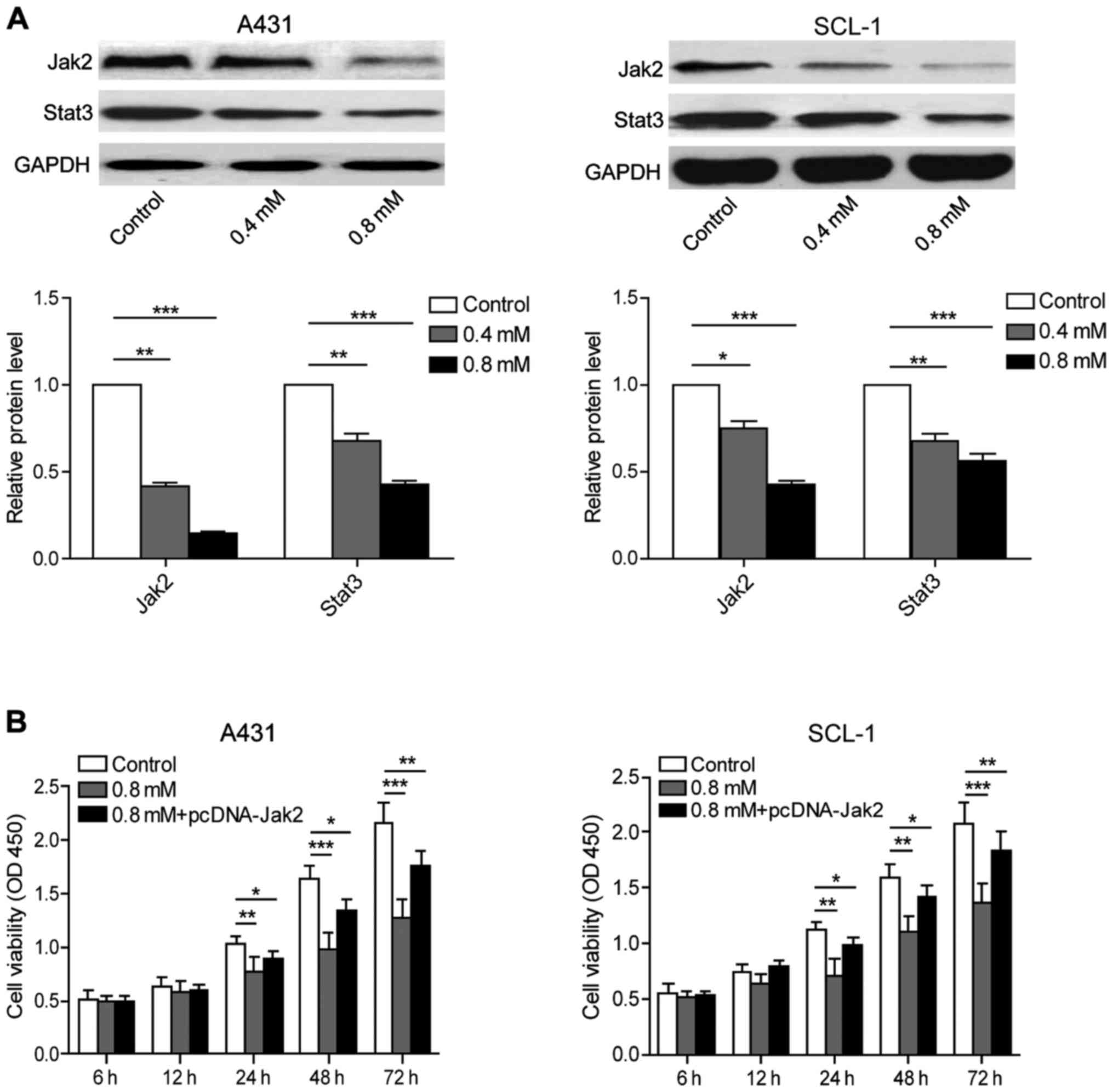|
1
|
Eisemann N, Waldmann A, Geller AC,
Weinstock MA, Volkmer B, Greinert R, Breitbart EW and Katalinic A:
Non-melanoma skin cancer incidence and impact of skin cancer
screening on incidence. J Invest Dermatol. 134:43–50. 2014.
View Article : Google Scholar : PubMed/NCBI
|
|
2
|
Jagadeeswaran R, Thirunavukkarasu C,
Gunasekaran P, Ramamurty N and Sakthisekaran D: In vitro studies on
the selective cytotoxic effect of crocetin and quercetin.
Fitoterapia. 71:395–399. 2000. View Article : Google Scholar : PubMed/NCBI
|
|
3
|
Jnaneshwari S, Hemshekhar M, Santhosh MS,
Sunitha K, Thushara R, Thirunavukkarasu C, Kemparaju K and Girish
KS: Crocin, a dietary colorant, mitigates cyclophosphamide-induced
organ toxicity by modulating antioxidant status and inflammatory
cytokines. J Pharm Pharmacol. 65:604–614. 2013. View Article : Google Scholar : PubMed/NCBI
|
|
4
|
Escribano J, Alonso GL, Coca-Prados M and
Fernandez JA: Crocin, safranal and picrocrocin from saffron
(Crocus sativus L.) inhibit the growth of human cancer cells
in vitro. Cancer Lett. 100:23–30. 1996. View Article : Google Scholar : PubMed/NCBI
|
|
5
|
Abdullaev FI and Espinosa-Aguirre JJ:
Biomedical properties of saffron and its potential use in cancer
therapy and chemoprevention trials. Cancer Detect Prev. 28:426–432.
2004. View Article : Google Scholar : PubMed/NCBI
|
|
6
|
Kerr JF, Wyllie AH and Currie AR:
Apoptosis: A basic biological phenomenon with wide-ranging
implications in tissue kinetics. Br J Cancer. 26:239–257. 1972.
View Article : Google Scholar : PubMed/NCBI
|
|
7
|
Ishizuka F, Shimazawa M, Umigai N,
Ogishima H, Nakamura S, Tsuruma K and Hara H: Crocetin, a
carotenoid derivative, inhibits retinal ischemic damage in mice.
Eur J Pharmacol. 703:1–10. 2013. View Article : Google Scholar : PubMed/NCBI
|
|
8
|
Abdullaev FI: Cancer chemopreventive and
tumoricidal properties of saffron (Crocus sativus L.). Exp
Biol Med (Maywood). 227:20–25. 2002. View Article : Google Scholar : PubMed/NCBI
|
|
9
|
García-Olmo DC, Riese HH, Escribano J,
Ontañón J, Fernandez JA, Atiénzar M and García-Olmo D: Effects of
long-term treatment of colon adenocarcinoma with crocin, a
carotenoid from saffron (Crocus sativus L.): An experimental
study in the rat. Nutr Cancer. 35:120–126. 1999. View Article : Google Scholar : PubMed/NCBI
|
|
10
|
Hawkins RE, Russell SJ and Winter G:
Selection of phage antibodies by binding affinity. Mimicking
affinity maturation. J Mol Biol. 226:889–896. 1992. View Article : Google Scholar : PubMed/NCBI
|
|
11
|
Smith GP: Filamentous fusion phage: Novel
expression vectors that display cloned antigens on the virion
surface. Science. 228:1315–1317. 1985. View Article : Google Scholar : PubMed/NCBI
|
|
12
|
Davies J and Riechmann L: An antibody VH
domain with a lox-Cre site integrated into its coding region:
Bacterial recombination within a single polypeptide chain. FEBS
Lett. 377:92–96. 1995. View Article : Google Scholar : PubMed/NCBI
|
|
13
|
Xu C, Bailly-Maitre B and Reed JC:
Endoplasmic reticulum stress: Cell life and death decisions. J Clin
Invest. 115:2656–2664. 2005. View
Article : Google Scholar : PubMed/NCBI
|
|
14
|
Azmi AS, Wang Z, Philip PA, Mohammad RM
and Sarkar FH: Emerging Bcl-2 inhibitors for the treatment of
cancer. Expert Opin Emerg Drugs. 16:59–70. 2011. View Article : Google Scholar : PubMed/NCBI
|
|
15
|
Lin Q, Lai R, Chirieac LR, Li C, Thomazy
VA, Grammatikakis I, Rassidakis GZ, Zhang W, Fujio Y, Kunisada K,
et al: Constitutive activation of JAK3/STAT3 in colon carcinoma
tumors and cell lines: Inhibition of JAK3/STAT3 signaling induces
apoptosis and cell cycle arrest of colon carcinoma cells. Am J
Pathol. 167:969–980. 2005. View Article : Google Scholar : PubMed/NCBI
|
|
16
|
Gao B, Shen X, Kunos G, Meng Q, Goldberg
ID, Rosen EM and Fan S: Constitutive activation of JAK-STAT3
signaling by BRCA1 in human prostate cancer cells. FEBS Lett.
488:179–184. 2001. View Article : Google Scholar : PubMed/NCBI
|
|
17
|
Grandis JR, Drenning SD, Zeng Q, Watkins
SC, Melhem MF, Endo S, Johnson DE, Huang L, He Y and Kim JD:
Constitutive activation of Stat3 signaling abrogates apoptosis in
squamous cell carcinogenesis in vivo. Proc Natl Acad Sci USA.
97:4227–4232. 2000. View Article : Google Scholar : PubMed/NCBI
|
|
18
|
Bromberg J and Darnell JE Jr: The role of
STATs in transcriptional control and their impact on cellular
function. Oncogene. 19:2468–2473. 2000. View Article : Google Scholar : PubMed/NCBI
|
|
19
|
Dell'Albani P, Kahn MA, Cole R, Condorelli
DF, Giuffrida-Stella AM and de Vellis J: Oligodendroglial survival
factors, PDGF-AA and CNTF, activate similar JAK/STAT signaling
pathways. J Neurosci Res. 54:191–205. 1998. View Article : Google Scholar : PubMed/NCBI
|
|
20
|
Leong PL, Andrews GA, Johnson DE, Dyer KF,
Xi S, Mai JC, Robbins PD, Gadiparthi S, Burke NA, Watkins SF, et
al: Targeted inhibition of Stat3 with a decoy oligonucleotide
abrogates head and neck cancer cell growth. Proc Natl Acad Sci USA.
100:4138–4143. 2003. View Article : Google Scholar : PubMed/NCBI
|
|
21
|
Xia L, Wang L, Chung AS, Ivanov SS, Ling
MY, Dragoi AM, Platt A, Gilmer TM, Fu XY and Chin YE:
Identification of both positive and negative domains within the
epidermal growth factor receptor COOH-terminal region for signal
transducer and activator of transcription (STAT) activation. J Biol
Chem. 277:30716–30723. 2002. View Article : Google Scholar : PubMed/NCBI
|
|
22
|
Bromberg JF, Wrzeszczynska MH, Devgan G,
Zhao Y, Pestell RG, Albanese C and Darnell JE Jr: Stat3 as an
oncogene. Cell. 98:295–303. 1999. View Article : Google Scholar : PubMed/NCBI
|
|
23
|
Niu G, Wright KL, Huang M, Song L, Haura
E, Turkson J, Zhang S, Wang T, Sinibaldi D, Coppola D, et al:
Constitutive Stat3 activity up-regulates VEGF expression and tumor
angiogenesis. Oncogene. 21:2000–2008. 2002. View Article : Google Scholar : PubMed/NCBI
|













